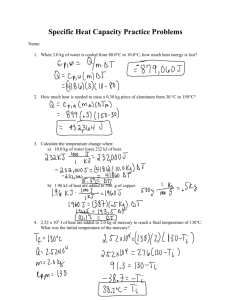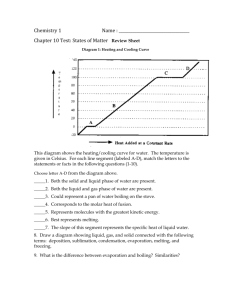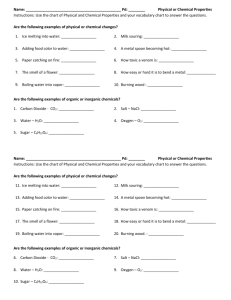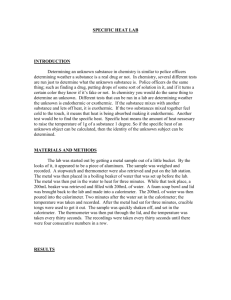WPHS Chemistry
advertisement
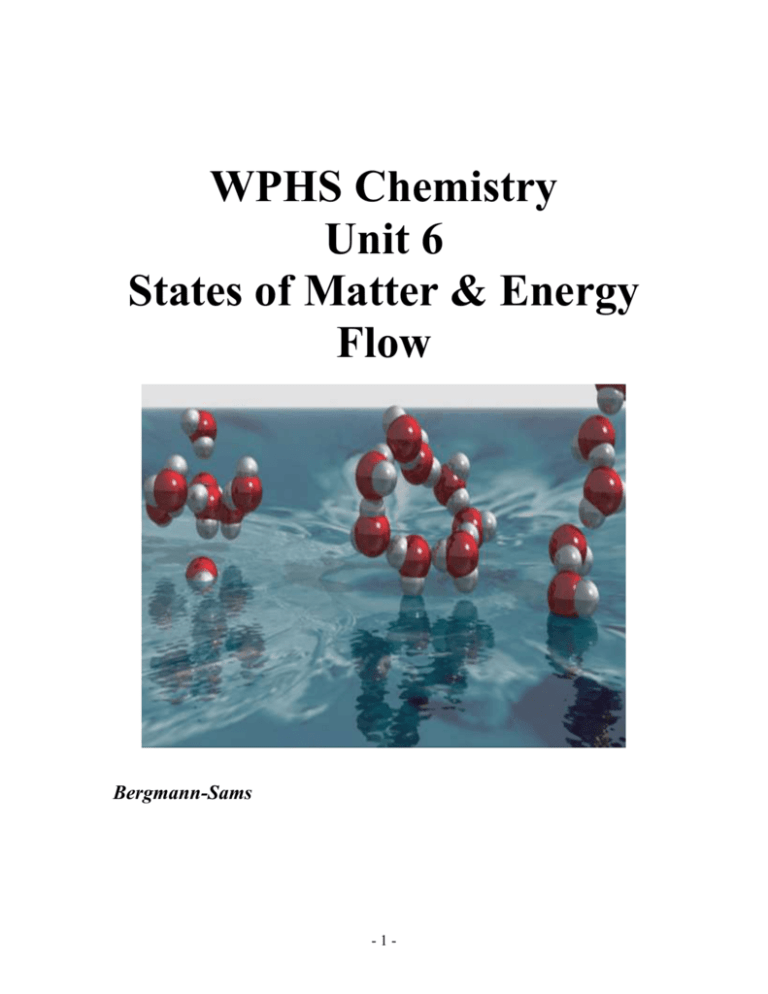
WPHS Chemistry Unit 6 States of Matter & Energy Flow Bergmann-Sams -1- Matter Chemistry: Unit 6 Outline: States of Assignment Podcast 6.1 KMT and Pressure Worksheet 6.1 KMT and Pressure Aluminum Can Crush Podcast 6.2 Vapor Pressure and Phase Diagrams Demo: Boiling Water with Ice Worksheet 6.2 Vapor Pressure and Phase Diagrams Demo: Triple Point of CO2 Podcast 6.3 Energy Transformations Worksheet 6.3 Energy Transformations Lab: What factors affect heat flow? Podcast 6.4 Heat Capacity Worksheet 6.4 Heat Capacity Lab: Heat Capacity of a Metal Podcast 6.5 Energy Stoichiometry Worksheet 6.5 Energy Stoichiometry Podcast 6.6 Calorimetry Worksheet 6.6 Calorimetry Lab: Heat of Reaction: Magnesium Podcast 6.7 Phase Change Problems Conceptual Worksheet 6.7 Phase Change Problems Conceptual Demo: Burning Paper with Steam Podcast 6.8 Phase Change Problems Mathematical Worksheet 6.8 Phase Change Problems Mathematical Lab: Heat of Fusion of Ice Unit 6 Vocabulary Lab Test: Finding ∆H Unit 6 Exam -2- In ClassOnly? Heat System Surroundings Universe Law of conservation of energy Endothermic process Exothermic process Calorie Joule Heat capacity Specific heat Calorimetry Calorimeter Enthalpy Thermochemical equation Heat of reaction Heat of combustion Molar heat of fusion Molar heat of solidification Molar heat of vaporization Molar heat of condensation Molar heat of solution Heat of formation Unit 6: Vocabulary Kinetic theory Kinetic energy Gas pressure Vacuum Atmospheric pressure Barometer Pascal Standard atmosphere (atm) Vaporization Evaporation Vapor pressure Boiling point Normal boiling point Melting point Crystal Allotropes Amorphous solids Phase diagram Triple point Sublimation Thermochemistry Energy Chemical potential energy -3- Title: Aluminum Can Crush—Take Home Lab Subject/Concept: Chemistry - Gas Laws Purpose: The purpose of this activity is to observe the gas laws in action. Materials: •1/8 cup water • small pan of ice water • 1 empty aluminum soda can • 1 pair barbeque tongs • 1 stove Procedure: 1. Place 1/8 cup of water in an empty aluminum soda can. 2. Heat the can of water on the stove on medium until visible steam escapes from the can for a period of about 5-10 seconds. 3. With the barbeque tongs, grab the can and invert it into the pan of ice water. Cautions: 1. Do not boil the can dry! It will melt onto the stove top! 2. Do not touch the aluminum cans with your hands while it is on the stove. It is very hot. 3. Be careful not to spill or splash any of the boiling water in the can as you invert it. Questions: 1. What gas replaces the air while the water is boiling? 2. What is the chemical formula for the gas in question #1? 3. Explain how each of the following contributes to the results: a) the temperature of the gas cools when the can is removed from the heat b) the gas inside the can condenses to form water droplets 4. What is the difference between an implosion and an explosion? 5. If cans are roughly 8” in circumference and 4.75” tall, how many pounds of pressure does the atmosphere place on the outside of the can? (1 atm = 14.7psi ) For Credit: To receive credit, your parent or guardian must write a short note confirming that you performed the experiment for them and explained the results to their satisfaction using the concept of gas laws. Attach your note to the back of this sheet. -4- Lab: What factors affect heat flow? Pre-Experiment Discussion Chemical and physical changes are always accompanied by a change in energy. Most commonly this energy change is observed as a flow of heat energy. Previous Knowledge: Understand basics of heat transfer Knowledge of types of energy Questions: 1. Two objects with different temperatures are touching. Describe the heat flow. Which direction does the heat flow? Why? How will the temperatures of each object change? When will the heat flow cease? What will the final temperatures be? 2. Discuss with your group the Question of the Day. Present a summary of your ideas to the rest of the class. Materials: beaker, 400-mL Bunsen burner/hotplate wire gauze ring stand test tube tongs electronic balance 4 materials in small pieces test tube, large thermometer graduated cylinder, 100-mL Styrofoam cups, 2, with lid Safety Alert: All materials being used around the Bunsen burner should be assumed to be hot. Metal and glass looks the same hot as it does cold. Use heat resistant gloves to handle hot objects. Wear Safety Goggles the entire time! Procedure: 1. Set up your Bunsen burner, wire gauze, and ring stand. Fill your 400-mL beaker about 4/5 full of tap water. Set it on your wire gauze. Light the Bunsen burner so the water can be heating as you prepare the sample of metal. -5- 2. Using the electronic balance, obtain about _____ g of the __________. Record the exact mass on your data table. Put an X in the box for the sample that you will be studying.** other ideas: sand, soil, antifreeze, water, Masses 40 g 60 g 80 g Substances Aluminum Copper Zinc Glass 3. Add the substance to your large test tube. Put your thermometer in the middle of the pieces so it can track the temperature of the sample. It might be easier to add some pieces, then insert the thermometer, and then add the rest of the metal pieces around it. 4. Gently place the test tube in the warm water. Be sure that the entire sample of the substance is below the water line. Answer In-Lab Question #1. 5. Prepare your calorimeter by stacking two Styrofoam cups together. 6. Measure exactly 100 mL of tap water into the calorimeter. 7. Insert your second thermometer into the opening in the lid of your calorimeter. Record the temperature of your water in the data table. 8. Allow the metal to reach a temperature between 85 and 90 °C. Measure and record the exact temperature of the metal in the test tube in your data table. 9. Answer In-Lab Question #2. Work quickly but carefully: remove the lid of the calorimeter and empty the hot metal from the test tube into the calorimeter. Replace the calorimeter lid and thermometer. Set the test tube aside. 10. Answer In-Lab Question #3. Gently swirl the mixture of metal and water in your calorimeter. Watch the reading on the thermometer. Record the highest temperature reached for the mixture in your data table. Answer In-Lab Question #4. 11. To cleanup, remove the thermometer from the calorimeter. With the lid on your calorimeter to catch the metal pieces, pour the water into the sink. Put the wet metal caught in the lid in the labeled container to dry. 12. Repeat Steps 1-11 two more times. In-Lab Questions: Discuss and answer questions with your partner at the appropriate times noted in the procedure. 1. Is the temperature of the metal before heating important? Explain. 2. Why would the hot metal need to be transferred to the water quickly? 3. What is the purpose of the swirling? 4. What would happen to the temperature of the mixture if it was allowed to sit longer? Explain. -6- Data Table Pair Data Collected Type of Substance Trial 1 Trial 2 Mass of substance Temperature of water Temperature of substance Temperature of mixture Trial 3 g g g °C °C °C °C °C °C °C °C °C Post-Experiment Questions: Discuss and answer questions with your partner at the appropriate times noted in the procedure. After you have finished, compare your answers with the other members of your larger group and discuss any differences. 1. Which part of the mixture, the substance or the water, was releasing heat? Which was absorbing heat? How do you know? 2. What can you say about the final temperature of the objects? 3. Calculate the change in temperature of the water for each trial and then calculate the average of these values. 4. Calculate the change in temperature of the metal for each trial and then calculate the average of these values. 5. Compare the change in temperatures of the three metal samples. Describe any trend you find. 6. Propose a hypothesis for the pattern you have observed. -7- 7. Compare the change in temperature of the water to the change in temperature of the metal. Describe any trend you find. 8. Propose a hypothesis for the pattern you have observed. 9. Create one line graph of mass of metal vs. the inverse of the average change in temperature of the metal (mass vs. 1/∆T) for each of the four metals. Make each of the four lines a different color. Add a line of best-fit for each metal and display the equation on the chart. 10. Discuss with your group the meaning of the slope. Summarize your ideas here. 11. Which metal has the highest slope? Which has the lowest slope? 12. What do these differences suggest about how these metals transfer heat? 13. Based on the data from this experiment, summarize the factors that affect heat transfer. 14. Brainstorm properties of the different materials that might account for their different heat flow behaviors. 15. Using grammatically correct sentences compare the heat transfer ability of each material tested. 16. If a similar experiment was done using 100 mL of water at 20°C with 100 g of metal at 80°C, what would you expect the approximate final temperature to be? Explain. -8- 17. Assuming an island and inland areas or exposed to the same amount of heat energy, why would the island have less drastic temperature changes than inland area? 18. How would you determine Styrofoam’s ability to transfer heat? What difference, if any, would you find in its behavior compared to metal? What is a common use of Styrofoam that capitalizes on this idea? 19. If 5 g samples of glass and copper are placed on the same hot plate and allowed to heat for one minute, how would their final temperatures compare? Explain. 20. Reflecting on what you have learned throughout the experiment, summarize what you have learned about heat transfer. -9- - 10 - WPHS Chemistry Identification of an Unknown Metal In this lab we will be using lab techniques and basic chemical concepts to identify an unknown metal. Every metal has a unique set of properties. We will be using specific heat (also known as "heat capacity" or "specific heat capacity"). Your periodic tables have adequate listings for the purpose of this experiment, but several other sources also have listings of these values for pure materials: check the indices of the CRC Handbook, the Merck Index, or the Exploring the Elements books on the shelves around the room. NOTES: Goggles are necessary, and long hair must be tied back . Record all data to the correct decimal place in your lab handbook. Since we are using digital thermometers, feel free to stir with the thermometer. PROCEDURE - Specific Heat To determine the specific heat of a metal sample, we will use a calorimeter, and the concept that in a closed system, heat lost by a hot object is gained by a cooler one. mCp∆T (cold) = –mCp∆T (hot) To determine the initial (high) temperature of your metal sample, suspend it in a beaker of boiling water and keep it there until boiling has proceeded steadily for about two minutes. Record the temperature of the boiling water with a thermometer in a rubber stopper (it should not touch the beaker glass). This is the same as the initial metal temperature. While the water/metal mixture is boiling, record the mass of the empty calorimeter cup. Next, add just enough water to cover your piece of metal (estimate), and determine the combined mass. Keep track of the temperature of this water with a second thermometer. Record the temperature of the cold water and of the metal just before combining them. Immerse the metal sample in the cold water and record the final temperature of the mixture. It should change quickly at first, then level off, then cool back down slowly. Record the level part. NOTE: Perform one density trial then one specific heat trial, then repeat the whole thing two more times. Make sure Everything is dry for each trial. - 11 - Data Table Trial 1 Trial 2 Trial 3 initial temperature of metal __________ __________ __________ (C) temperature of cold water __________ __________ __________ (C) final temperature of mixture __________ __________ __________ (C) specific heat of water 4.18 4.18 4.18 (J/gC) mass of cold water (use Vol) __________ __________ __________ (g) change in water temperature __________ __________ __________ (C) change in metal temperature __________ __________ __________ (C) specific heat of metal __________ __________ __________ (J/gC) Show a complete sample calculation for heat capacity and then determine which metal you have using the table below Metal Specific Heat (J/g ºC) Aluminum 0.91 Cast Iron 0.46 Iron 0.46 Molybedenum 0.25 Tin 0.21 Metal Antimony Copper Lead Nickel Titanium Specific Heat (J/g ºC) 0.21 0.39 0.13 0.54 0.54 - 12 - Metal Specific Heat (J/g ºC) Carbon Steel 0.49 Gold 0.13 Magnesium 1.05 Sliver 0.23 Zinc 0.39 HEAT OF REACTION OF MAGNESIUM Description The mass of a measured length of polished magnesium ribbon is determined. A small length of ribbon is cut and its length measured. From the length of the small piece, its mass is calculated. A known volume of acid is placed in a calorimeter. The temperature is measured. The magnesium is added to the calorimeter, and a reaction takes place. The temperature is measured once reaction ceases. From the mass of ribbon reacted, the temperature increase, and the volume of acid used, the heat of formation of Mg2+(aq) is determined. Hazards Magnesium burns in a very exothermic reaction. Never look directly at burning magnesium. Cuts when polishing the magnesium metal are possible. The dilute acid is corrosive. Precautions Keep magnesium away from ignition sources such as open flames. Wear gloves when polishing the magnesium metal ribbon. Wear eye protection; wash acid spills immediately. Procedure Demonstration: 1. Place 100 mL of 3 M hydrochloric acid in a 250-mL beaker. Fold a 10-cm length of magnesium ribbon, place in the solution, and note evidence for reaction. Experiment: 1. 2. 3. 4. Carefully measure and record the length of one of the cut pieces of polished magnesium ribbon. Obtain the mass of a 1.00 meter length of polished magnesium ribbon from your instructor. Crumple the piece of magnesium into a small ball. Pour 50-60 mL of 3 M hydrochloric acid into a 100-mL cylinder. Measure and record the exact volume to the nearest 0.2 mL. Assemble a calorimeter. - 13 - 5. 6. 7. 8. A calorimeter assembled from three foam cups works well. Two nested cups hold the fluid. One fourth of the third cup is removed at the lip. A hole is made in the bottom for the thermometer; a hole is made in the side near the upper edge through which additions can be made. When inverted, this piece serves as a calorimeter cover. Pour the measured volume of acid into the inner calorimeter cup. Cover. Insert the thermometer. Read and record the temperature to the nearest 0.1 °C at regular intervals until it becomes constant. Add the crumpled magnesium to the acid solution. Swirl gently. Note the temperature. Record the maximum temperature reached by the hydrochloric acid solution. Data length magnesium ribbon (cm) mass Mg/ m (provided by instructor) mass Mg used mol Mg used volume HCl (mL) initial temperature, °C maximum temperature, °C temperature rise, °C energy released (J) energy released/ mol Mg (kJ/mol) Percent Error Accepted value = -462.0 kJ/mol at 25 °C for 1 M H+ 1. 2. 3. Write an equation for the reaction of magnesium metal with hydrochloric acid. Include the heat of reaction calculated above. State the relationship between the heat of reaction for this reaction and the heat of formation of aqueous magnesium ion. The accepted heat of formation of Mg2+(aq) is -462.0 kJ/mol (25 °C, 1 M). Find the percent error for the experiment - 14 - Heat of Fusion of Ice Name INTRODUCTION: The amount of energy required to convert a solid to a liquid, at constant pressure and temperature, is called the heat of fusion of the substance. In this experiment, the heat of fusion of ice will be determined. The ice will be melted by placing it in a known volume of hot water contained in a plastic cup. The system will be left undisturbed until all the ice has melted. The amount of heat lost by the hot water in this process can be calculated according to the following equation. Procedure 1. Get 100.0 mL of water at the highest temperature you can out of the tap. 2. Place the water in a Styrofoam cup. 3. Measure the temperature of the water. 4. Simultaneously, the other partner should be getting a handful of ice cubes that need to be dried. 5. Place the ice cubes in the cup of hot water and wait until the ice cubes have completely melted. 6. Measure the final temperature. 7. Measure the total volume of the cool water. 8. Place all data in the table below. 9. For the masses: Assume that the density of water is 1.0 g/mL. DATA TABLE: Initial mass of hot water. g Initial temperature of hot water. ºC Final temperature of water and melted ice. ºC Final mass of water and melted ice. Change in Temp of Hot Water Change in Temp of Ice mass of ice added g ºC ºC g - 15 - Calculations 1. Assuming that the heat gained by the ice (Qice) is equal to the heat lost by the warm water (Qwarm water) you can solve for the value of ΔH for ice. mice cΔT + ΔHfusmice = mwarm water cΔT Where the left side of the equation represents the ice melting and then warming up to the final temperature and the right side represents the energy lost by the warm water. Now solve for ΔHfus . Questions 1. The accepted value for the heat of fusion of water (ice) is 334 joules/g. What is your percentage of error? 2. What is the most important source of error? 3. What happened to the temperature of the ice as it was melting? - 16 - Worksheet 6.1: KMT and Pressure Name _____________________ 1. Use kinetic theory to explain what causes gas pressure. 2. Convert the following Pressures: a. 600 mm Hg into atm b. 190 kPa into atm c. 2.3 atm into mm Hg d. 1.5 atm into kPa 3. What is the equation that relates kinetic energy to Kelvin Temperature 4. What is the temperature at absolute zero 5. Use kinetic theory to explain the difference between evaporation and boiling of a liquid. - 17 - 6. Use the chart to answer the following questions. a. What is the vapor pressure of ether at 40ºC? b. What is normal boiling point of water? c. What is the normal boiling point of benzene? 7. How is the average kinetic energy of water molecules affected when you pour hot water from a kettle into cups at the same temperature as the water? - 18 - Worksheet 6.2 Vapor Pressure and Phase Diagrams Name __________________ 1. What is the relationship between atmospheric pressure and altitude? What effect does this have on the boiling point of water? 2. Define vapor pressure. 3. What is the full definition of the boiling point of a liquid? 4. Explain why the boiling point of a liquid varies with atmospheric pressure. 5. Using the diagram above: What would happen to the CO2 if you: a. Heat it up from -60º to 30º C at 6.0 atm? b. Increase the pressure from 2.0 atm to 60 atm at a temperature of 0ºC? c. Decrease the pressure from 80.0 atm to 1 atm at a temperature of 25ºC? d. Increase the temperature from -80ºC to +80ºC at a pressure of 1.0 atm? e. Increase the temperature from -60ºC to 20ºC at a pressure of 70 atm? - 19 - WS 6.3: Energy Transformations Name ________________ 1. Which has more heat: Rampart Reservoir or a cup of boiling water? Explain your answer. 2. What always happens when two object of different temperatures come into contact? Give an example from your daily life. 3. Classify these process as exothermic or endothermic: Condensing steam Evaporating alcohol Burning alcohol Baking a potato 4. Energy always flows from _______ to _____________. 5. When you open your door in the winter and your mom says: “Quit letting the cold in the house,” what should you politely tell her? - 20 - WS 6.4 Heat Capacity Substance Heat Capacity (J/gºC) Water 4.18 Substance Heat Capacity (J/gºC) Grain 2.4 Alcohol Ice 2.1 Steam 1.7 Chloroform 0.96 Aluminum 0.90 Glass 0.50 Iron 0.46 Silver 0.24 Mercury 0.14 Lithium 0.14 Copper 0.39 Uranium 0.12 Gold 0.13 Use the table above to answer the following questions 1. A 75.0g sample of a metal at 98.0º C is dropped into a container of 350. g of water at 24.0ºC, The final temperature is 24.5 ºC. What is the specific heat of the metal? 2. A 55.0 g sample of a metal at 90.0º C is dropped into a container of 250 g of water at 22.0ºC, The final temperature is 23.4 ºC. What is the metal? 3. A 200.0 g sample of a metal at 92.0º C is dropped into a container of 100 g of water at 26.0ºC, The final temperature is 45.6 ºC. What is the metal? What is the percentage error? 4. A 45.2 g sample of Silver at 101.0 ºC is dropped into 300.0 g of water at 30.6 ºC. What is the final temperature of the water? - 21 - WS 6.5: Energy Stoichiometry 1. Name __________________ Nitrogen reacts with hydrogen according to the following equation. N2 + H2 NH3 + 231 kJ How much energy will be released when 13.0-g of nitrogen reacts? How much energy will be released when 2.5L of hydrogen reacts? 2. Carbon disulfide is an important industrial solvent. It is prepared by the reaction of coke with sulfur dioxide: 5C(s)+2SO2(g) CS2(s) +4CO(g) ∆H = 23.5-kJ How much energy will be required when 32.4-g of Carbon disulfide is produced? How much energy will be required to react 21.1-L of sulfur dioxide? 3. Silver nitrate reacts with calcium to make calcium nitrate and silver. The reaction is exothermic and produces 18.7 kJ/mol of energy. AgNO3+ Ca Ca(NO3)2 + Ag How much energy will be produced when 12.3-g of silver nitrate react? How many grams of silver nitrate reacted if 13.7 kJ of energy is released? - 22 - 4. Magnesium reacts with hydrochloric acid in a single replacement reaction. The value of ∆H =-221 kJ/mol. (You will need to write the balanced chemical equation. How many grams of magnesium will be made if 365-kJ is released? How much energy will be released if 9.45-g of magnesium reacts? 5. Ammonium sulfate reacts with barium hydroxide endothermically. ∆H = + 127 kJ/mol. (You will need to write the balanced chemical equation.) How much energy will be required to react completely 34.5-g of barium hydroxide? If 395-kJ of energy is absorbed, how many grams of ppt will be formed? - 23 - WS 6.6 Calorimetry 1. When 12.3-g of magnesium reacts with 1000.0g of hydrochloric acid it raises the temperature from 22.5˚C to 48.3˚C. What is the value of ∆H? 2. When 13.5-g of ammonium nitrate is dissolved in water it cools 1000.0-g of water from 32.3˚C to 29.5˚C. What is the value of ∆H? 3. The combustion of 25.6-g of propane, C3H8 raises the temperature of 1000-g of water by 16.8˚C. What is the value of ∆H? 4. The single replacement reaction: Li + Al2(SO4)3 Li2SO4 + Al has a ∆H of –229.7 kJ/mol. If 12.1-g of Li reacts, how much will the temperature of 1000.0-g of water rise? (Hint: balance the reaction and then use Q=mc∆T and solve for ∆T) 5. For the dissolving of sulfuric acid, H2SO4 the value of ∆H=-236 kJ/mol. If 2.54-g of sulfuric acid dissolves in 100.0-g of 20.0˚C water, what will be the final temperature of the water? - 24 - WS 6.7: Phase Change Problems Conceptual Name____________________ C 1. In the diagram above, label all of the states of matter. 2. Assuming the above diagram is water, label the temperatures of the flat portions of the diagram above. 3. In the first rising portion of the graph (a), describe what is happening as energy is added. Discuss this in terms of the kinetic molecular theory. 4. In the 1st flat portion of the graph (b), describe what is happening as energy is added. Discuss this in terms of bonding forces of attraction. 5. In the 2nd rising portion of the graph (c), describe what is happening as energy is added. Discuss this in terms of the kinetic molecular theory. 6. In the 2nd flat portion of the graph (d), describe what is happening as energy is added. Discuss this in terms of bonding forces of attraction. 7. In the 3rd rising portion of the graph (e), describe what is happening as energy is added. Discuss this in terms of the kinetic molecular theory - 25 - 8. What is the formula used for calculating the heat involved in a phase change? 9. During a phase change, how much does the temperature change? How much does the KE change? Does the potential energy change? 10. What is the formula used to calculate the heat required to warm or cool one phase of matter? 11. When you heat one phase of matter, how do you know that the KE changes? 12. What is meant by the negative sign in an answer like "-46.8 kJ"? When would you use a positive sign? - 26 - WS 6.8: Phase Change Problems Mathematical Name____________________ m.p. (ºC) 0.00 ∆Hfus (kJ/g) 0.333 b.p. ºC 100.00 ∆Hvap (kJ/g) 2.26 Grain Alcohol -98 0.0987 64 1.10 Benzene 5.0 0.1265 80 0.394 Substance H2O Specific Heat –C(J/g ºC) Ice: 2.09 Water: 4.18 Steam: 1.7 Solid: 1.2 Liquid: 2.4 Gas: 1.9 Solid: 0.55 Liquid: 0.96 Gas: 1.09 1. If you must add 25 kJ to raise the temperature of an ice cube from -15°C to -10°C, is this an endothermic or an exothermic process. 2. How much heat is required to raise 40 grams of water from 30°C to 70°C? 3. How much water can be raised from 25°C (room temperature) to 37°C body temperature by adding the 2,000 kJ in a Snickers Bar? 4. How much heat does it take to melt 65 grams of ice at 0°C? - 27 - 5. Calculate the amount of energy required to change 100 grams of solid ice at 0°C to gaseous steam at 100°C. (Be aware of units: kJ or J?) How many steps does this take? 6. Calculate the amount of energy released by cooling 59 grams of liquid water from +25°C to ice at -25°C. (Be aware of units: kJ or J?) How many steps does this take? 7. How much heat would it take to raise 5 grams of H2O from -50°C to +200°C? How many steps does this take? 8. How much energy is required to bring 45 g of benzene from - 10˚C to 70˚C? - 28 -



